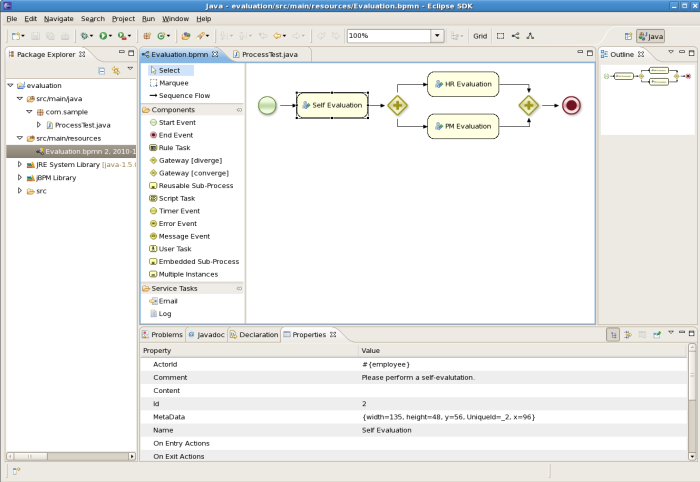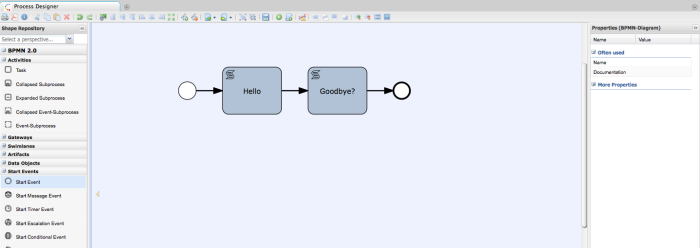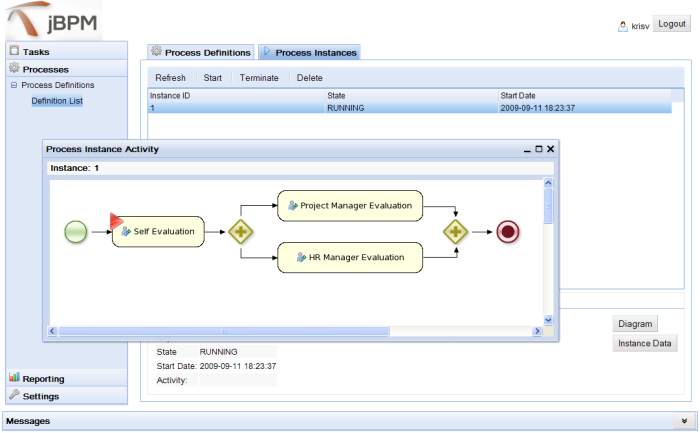jBPM is a flexible Business Process Management (BPM) Suite. It's light-weight, fully open-source (distributed under Apache license) and written in Java. It allows you to model, execute and monitor business processes, throughout their life cycle.
A business process allows you to model your business goals by describing the steps that need to be executed to achieve that goal and the order, using a flow chart. This greatly improves the visibility and agility of your business logic. jBPM focuses on executable business process, which are business processes that contain enough detail so they can actually be executed on a BPM engine. Executable business processes bridge the gap between business users and developers as they are higher-level and use domain-specific concepts that are understood by business users but can also be executed directly.

The core of jBPM is a light-weight, extensible workflow engine written in pure Java that allows you to execute business processes using the latest BPMN 2.0 specification. It can run in any Java environment, embedded in your application or as a service.
On top of the core engine, a lot of features and tools are offered to support business processes throughout their entire life cycle:
- Eclipse-based and web-based editor to support the graphical creation of your business processes (drag and drop)
- Pluggable persistence and transactions based on JPA / JTA
- Pluggable human task service based on WS-HumanTask for including tasks that need to be performed by human actors
- Management console supporting process instance management, task lists and task form management, and reporting
- Task for builder to create, generate and/or edit task forms
- Optional process repository to deploy your process (and other related knowledge)
- History logging (for querying / monitoring / analysis)
- Integration with Maven, Spring, OSGi, etc.
BPM makes the bridge between business analysts, developers and end users, by offering process management features and tools in a way that both business users and developers like it. Domain-specific nodes can be plugged into the palette, making the processes more easily understood by business users.
jBPM supports adaptive and dynamic processes that require flexibility to model complex, real-life situations that cannot easily be described using a rigid process. We bring control back to the end users by allowing them to control which parts of the process should be executed, to dynamically deviate from the process, etc.
jBPM is also not just an isolated process engine. Complex business logic can be modeled as a combination of business processes with business rules and complex event processing. jBPM can be combined with the Drools project to support one unified environment that integrates these paradigms where you model your business logic as a combination of processes, rules and events.
Apart from the core engine itself, there are quite a few additional (optional) components that you can use, like an Eclipse-based or web-based designer and a management console.
This figure gives an overview of the different components of the jBPM project. jBPM can integrate with a lot of other services as (and we've shown a few using grey boxes on the figure) but here we focus on the components that are part of the jBPM project itself.
- The process engine is the core of the project and is required if you want to
execute business processes (all other components are optional, as indicated by the dashed
border). Your application services typically invoke the core engine (to start processes or to
signal events) whenever necessary.
- An optional core service is the history log, that will log all information about the current and previous state of all your process instances.
- Another optional core service is the human task service, that will take care of the human task life cycle if human actors participate in the process.
- Two types of graphical editors are supported for defining your business processes:
- The Eclipse plugin is an extension to the Eclipse IDE, targeted towards developers, and allows you to create business processes using drag and drop, advanced debugging, etc.
- The web-based designer allows business users to manage business processes in a web-based environment. A web-based form builder also allows you to create, generate or edit forms related to those processes (to start the process or to complete one of the user tasks).
- The Guvnor repository is an optional component that can be used to store all your business processes. It supports collaboration, versioning, etc. There is integration with both the Eclipse plugin and web-based designer, supporting round-tripping between the different tools.
- The web-based management console allows business users to manage their runtime (manage business processes like start new processes, inspect running instances, etc.), to manage their task list and to perform Business Activity Monitoring (BAM) and see reports.
Each of the components are described in more detail below.
The core jBPM engine is the heart of the project. It's a light-weight workflow engine that executes your business processes. It can be embedded as part of your application or deployed as a service (possibly on the cloud). It's most important features are:
- Solid, stable core engine for executing your process instances
- Native support for the latest BPMN 2.0 specification for modeling and executing business processes
- Strong focus on performance and scalability
- Light-weight (can be deployed on almost any device that supports a simple Java Runtime Environment, does not require any web container at all)
- (Optional) pluggable persistence with a default JPA implementation
- Pluggable transaction support with a default JTA implementation
- Implemented as a generic process engine, so it can be extended to support new node types or other process languages
- Listeners to be notified of various events
- Ability to migrate running process instances to a new version of their process definition
The core engine can also be integrated with a few other (independent) core services:
- The human task service can be used to manage human tasks when human actors need to participate in the process. It is fully pluggable and the default implementation is based on the WS-HumanTask specification and manages the life cycle of the tasks, task lists, task forms and some more advanced features like escalation, delegation, rule-based assignments, etc.
- The history log can store all information about the execution of all the processes on the engine. This is necessary if you need access to historic information as runtime persistence only stores the current state of all active process instances. The history log can be used to store all current and historic state of active and completed process instances. It can be used to query for any information related to the execution of process instances, for monitoring, analysis, etc.
The Eclipse editor is a plugin to the Eclipse IDE and allows you to integrate your business processes in your development environment. It is targeted towards developers and has some wizards to get started, a graphical editor for creating your business processes (using drag and drop) and a lot of advanced testing and debugging capabilities.
It includes features like:
- Wizard for creating a new jBPM project
- A graphical editor for BPMN 2.0 processes
- Plugging in your own domain-specific nodes
- Validation
- Runtime support (so you can select which version of jBPM you would like to use)
- Graphical debugging, to see all running process instances of a selected session, to visualize the current state of one specific process instance, etc.
- Audit view to get an overview of what happened at runtime
- Unit testing your processes
- Integration with the knowledge repository
The web-based designer allows you to model your business processes in a web-based environment. It is targeted towards more business users and offers a graphical editor for viewing and editing your business processes (using drag and drop), similar to the Eclipse plugin. It supports round-tripping between the Eclipse editor and the web-based designer.
A web-based form builder allows you to create, generate and/or edit your form (both for starting a process or completing a user task) using a WYSIWYG editor. By dragging and dropping various form elements into a panel and filling in the necessary details, task forms can be created by non-technical experts.
Optionally, you can use one or more knowledge repositories to store your business processes (and other related artefacts). The web-based designer is integrated in the Guvnor repository, which is targeted towards business users and allows you to manage your processes separately from your application. It supports:
- A repository service to store your business processes and related artefacts, using a JCR repository, which supports versioning, remotely accessing it as a file system or using REST services, etc.
- A web-based user interface to manage your business processes, targeted towards business users, supporting the visualization (and editing) of your processes (the web-based designer is integrated here), but also categorisation, scenario testing, deployment, etc.
- Collaboration features to have multiple actors (for example business users and developers) work together on the same process definition.
- A knowledge agent to easily create new sessions based on the process definitions in the repository. This also supports (optionally) dynamically updating all sessions if a new process has been deployed.
Business processes can be managed through a web-based management console. It is targeted towards business users and its main features are:
- Process instance management: the ability to start new process instances, get a list of running process instances, visually inspect the state of a specific process instances, etc.
- Human task management: being able to get a list of all your current tasks (either assigned to you or that you might be able to claim), completing tasks on your task list (using customizable task forms), etc.
- Business Activity Monitorong (BAM) and Reporting: get an overview of the state of your application and/or system using dynamically generated (customizable) reports, that give you an overview of your key performance indicators (KPIs).
The documentation is structured as follows:
- Overview: the overview chapter gives an overview of the different components
- Getting Started: the getting started chapter teaches you where to download the binaries and sources and contains a lot of useful links
- Installer: the installer helps you getting a running demo setup including most of the jBPM components and runs you through them using a simple example and some 10-minute tutorials including screencasts
- Quickstarts: some tutorials for common tasks you might want to try out after successfully running the installer
- Core engine: the next 4 chapters describe the core engine: the process engine API, the process definition language (BPMN 2.0), persistence and transactions, and examples
- Eclipse editor: the next chapter describe the Eclipse plugin for developers
- Designer: describes the web-based designer that allows business users to edit business processes in a web-based context
- Console: the jBPM console can be used for managing process instances, human task lists and reports
- Important features
- Human tasks: When using human actors, you need a human task service to manage the life cycle of the tasks, the task lists, etc.
- Domain-specific processes: plug in your own higher-level, domain-specific nodes in your processes
- Testing and debugging: how to test and debug your processes
- Process repository: a process repository could be used to manage your business processes
- Advanced concepts
- Business activity monitoring: event processing to monitor the state of your systems
- Flexible processes: model much more adaptive, flexible processes using advanced process constructs and integration with business rules and event processing
- Integration: how to integrate with other technologies like maven, OSGi, Spring, etc.



